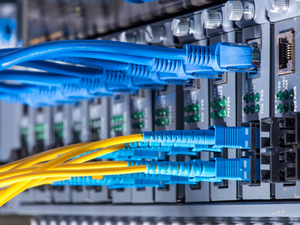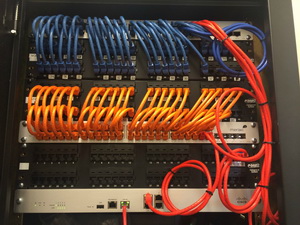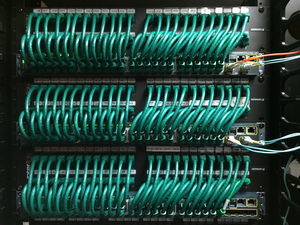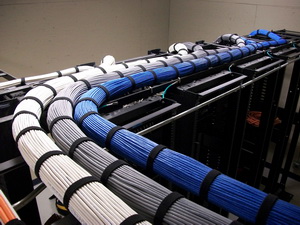Fiber Optic Cabling & Wiring Contractors
Fiber Optic Cabling & Wiring Contractors in Minneapolis St. Paul MN
Axis DataComm has the capability of installing, troubleshooting and repairing most types of fiber optic products. Fiber optics in your facility run the whole show, we will make sure that they stay up and running.
 Axis DataComm can match whatever type of product you currently have in place. We do not come in and just put in whatever we have in the truck, we will find out what product you have onsite beforehand and make sure we match it. A standardized system is one that works.
Axis DataComm can match whatever type of product you currently have in place. We do not come in and just put in whatever we have in the truck, we will find out what product you have onsite beforehand and make sure we match it. A standardized system is one that works.
Axis DataComm installs structured cabling systems that are easy to maintain. We provide complete network documentation including cable test results, as-built drawings and communication closet labeling that makes adds, moves and changes trouble free.
Whether your company requires re-cabling within an existing facility or you are planning an office move to a new facility, Axis DataComm can plan, manage and meet your needs on time and on budget.
With rapidly advancing technology, your business needs a reliable, high-performance cabling foundation that will successfully deliver information within and across your office.
Axis DataComm can provide the critical cabling infrastructure to handle today’s network needs and allow seamless migration into future technology.
Fiber Optic Cabling & Wiring Services
Fiber optic cable and fiber optic data transmission technology revolutionized data transfer in the late 20th century. By encoding data as pulses of light, rather than pulses of electricity, data densities on fiber optic cables far exceeded their copper counterparts. The data is sent, literally, at light-speed over fiber optic cables.
Single-Mode Fiber
Single-mode fibers have a narrower core and allow for one data stream, or mode, to be transmitted over very long distances. Single mode fiber carries far more bandwidth, but in a narrower spectral width, than multi-mode fiber.
Multi-Mode Fiber
Multi-mode fiber strands use a much thicker core than single mode. Multi-mode fiber can carry data encoded using multiple light sources, thus allowing for multiple data streams to travel over a single optical fiber. The downside of multi-mode is transmission distance and available data bandwidth. Multi-mode transmission is good over shorter distances and can not support the high bandwidth of single-mode fibers.
Plastic Fiber
Plastic optical fiber (POF) is usually not used for data transmission. Plastic fiber optic cables do not have the optical purity required for reliable data transmission. POF is usually used for decorative and aesthetic transmission of light. Examples of this are toys where light is transmitted through the fibers creating beautiful, colorful clumps of optical fibers. An added advantage of POF over glass fiber in entertainment or aesthetic situations is durability and cost. POF is much cheaper to manufacture than glass fiber and is not as fragile.
The Future of Fiber Optic Cable
Current research into future fiber optic cable technology will allow tunable cables similar to a radio. Data streams on a single mode fiber will be able to be contained within a particular light spectrum and will be tunable similar to a present-day radio.
Multimode Vs. Single-Mode Fiber
An optical fiber refers to a flexible, thin fiber through which light can be transmitted via internal reflections. Optical fibers can take the form of single-mode or multimode fibers.
Definitions
A single-mode fiber refers to an optical fiber designed to carry only one mode, or a single ray of light. A multimode fiber is optical fiber able to transmit multiple modes or light rays simultaneously, each at a different reflection angle within the optical fiber core.
Core Differences
Multimode fiber and single-mode fibers have significant core differences. Multimode fibers contain light-carrying cores that are 62.5 microns or more in diameter. Single-mode fiber contains a light-carrying core that has a diameter between 8 and 10 microns. A micron is one-millionth of a meter.
Bandwidth Differences
A multimode fiber provide bandwidth transmissions of a few hundred megahertz (MHz) per kilometer (km) of length. Multimode fibers permit transmission distances of up to approximately 10 miles and can be used with receivers and optic transmitters that are relatively inexpensive. Single-mode fibers transmit over distances greater than 10 miles, but must be used with solid-state laser diodes or other single-mode transmitters. A diode refers to a device composed of two terminals that conduct currents in one direction. Single-mode transmitters can be up to four times as expensive as multimode fiber equipment.
What Is Dual Mode Fiber Optic Cable?
A fiber optic cable is a thin glass strand used for transmitting light. Fiber optic cables are used primarily by telephone companies and electric companies. They are typically either single mode or dual mode, also called multimode.
Types
Single mode fiber optic cables are used for high speed and long distances; dual mode fiber optic cables are primarily used for short distances.
Details
Dual mode fiber optic cables have a slightly bigger diameter than single mode. Dual mode generally uses two fibers instead of one and offers a high bandwidth. Dual mode cables are not used for long distances, over 3,000 feet, because the multiple light paths lead to distortion to the receiving party.
Specifications
Dual mode fiber optic cables are made of glass and have diameters between 50 microns to 100 microns. Light is transferred through these cables using numerous paths. A single mode fiber optic contains a diameter between 8.3 microns to 10 microns and light is transferred via one path only.
Advantages & Disadvantages of Fiber Optic Cables
Fiber optic cabling for high speed Internet, telephone and cable connections is a technology with many advantages and limited disadvantages. Fiber optic cables transfer data via light waves. They are made from glass or plastic fibers in the core of the cable, surrounded by a "cladding" layer (designed to reflect light back towards the core), and the "buffer coating", which protects the fibers from moisture and other damage.
Advantage
Fiber optic data transmission is incredibly fast.
Advantage
Fiber optic cables are not susceptible to RF (radio frequency) interference, which can be a major problem for users of typical coaxial cabling.
Advantage
Fiber optic cables can transmit data over exceptionally long distances without much data loss.
Disadvantage
Often times, fiber optic cabling can cost more than double what a typical broadband connection costs, it is often hard for the average user to justify the costs.
Disadvantage
Fiber optic connections are not available in many areas.
Fun Fact
Many gaming systems and home theater components now also transfer information back and forth via fiber-optic cables.
Bandwidth Capacity of Fiber Optic Cable
Fiber optic cable transmits information using light signals. Fiber optic networks operate under the standards 10 Base-F, 100 Base-F, FDDI, FDDI duplex, 1000 Base-F and 10 Gbase, which include bandwidth capacity in their definitions.
Single and Multimode Fiber
Single mode fiber optic cable is the earliest form of fiber optic cable. This type of cable sends a single beam of light down the cable. Multimode fiber optic cable is an improved version of fiber optic communication. Because multimode fiber sends several light beams that combine into one signal, performance may be slightly higher, as the multimode installation includes several lasers which may combine to produce a maximum transmission rate greater than the specification standard rate to improve reliability. For example, a 10 gigabyte multimode network may include four lasers sending at 3 gigabytes.
10 Base-F
Older installations operate with lower bandwidth, especially if the signal is sent over long distances without amplification. The 10 Base-F standards from 1993 are the earliest standard for fiber optic transmission over Ethernet networks, according to the University of California, Berkeley. 10 Base networks send information at 10 megabytes per second.
Fiber Distributed Data Interface
FDDI, or fiber distributed data interface, is an alternative to an Ethernet network. FDDI is specifically designed for fiber optic communication, unlike Ethernet specifications designed for use with copper wires. FDDI uses both single mode cable to connect separate structures and multimode cable inside a structure, according to the University of California, Berkeley. FDDI networks are arranged in a ring of computers that pass an electronic token around the ring to communicate, this structure is known as a token ring network. The FDDI standard is a 100 megabyte per second network. FDDI-2 sends video images as well as data with a 100 megabyte per second standard. FDDI duplex mode sends data at double speed, allowing 200 megabyte per second communication.
Fast Ethernet
Some networks send data at 100 megabyte per second. The standards that govern these fiber networks are included in the 100 Base-F family. Any of the 100 Base, or 100 megabyte per second, standards including the fiber optic standard are referred to as Fast Ethernet.
1000 Base-F
Fiber Ethernet networks are installed under the 1000 Base-F standard. This standard allows transmission of data at one thousand megabytes per second. As with the other standard families there are related Ethernet specifications, such as 1000 Base-FX, that also operate at the same speed.
10 GBase
The 10 GBase standard covers Ethernet networks that include copper wires, wireless signals and fiber optic cables, so there is no separate 10 GBase-F standard. 10 Gbase standards govern networks that send information at 10 gigabytes per second.
More questions on Fiber Optic Cabling?
Just give us a call or take advantage of our free Data Cabling survey –we offer expert advice to clients planning to set up, upgrade or expand data cable installations – just drop us a line or call.



